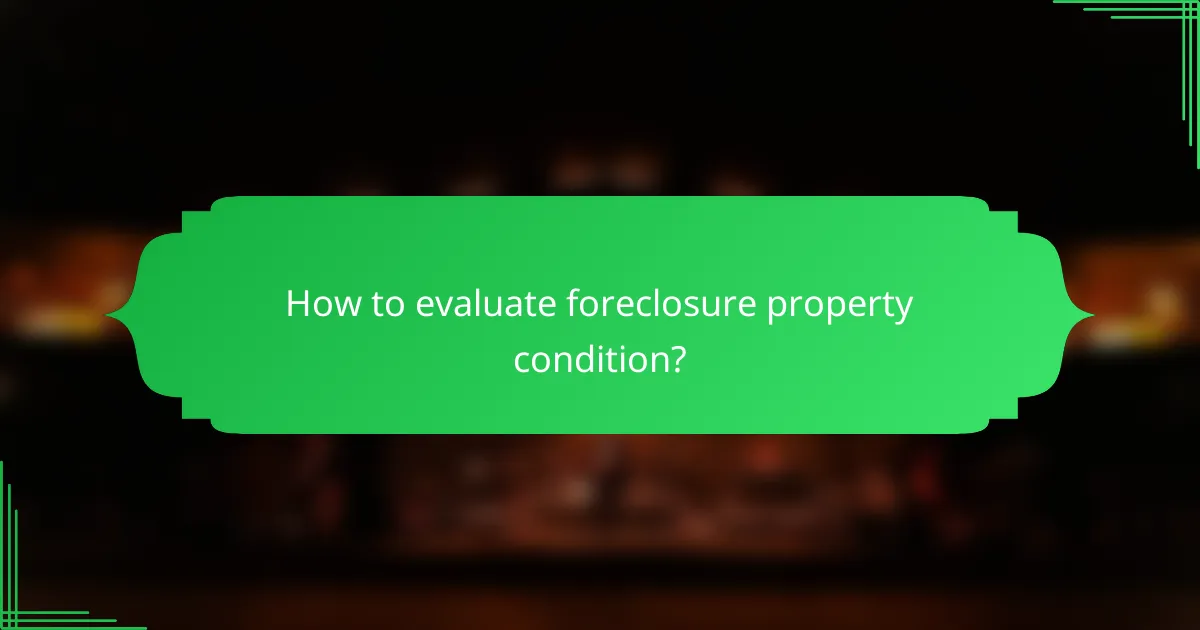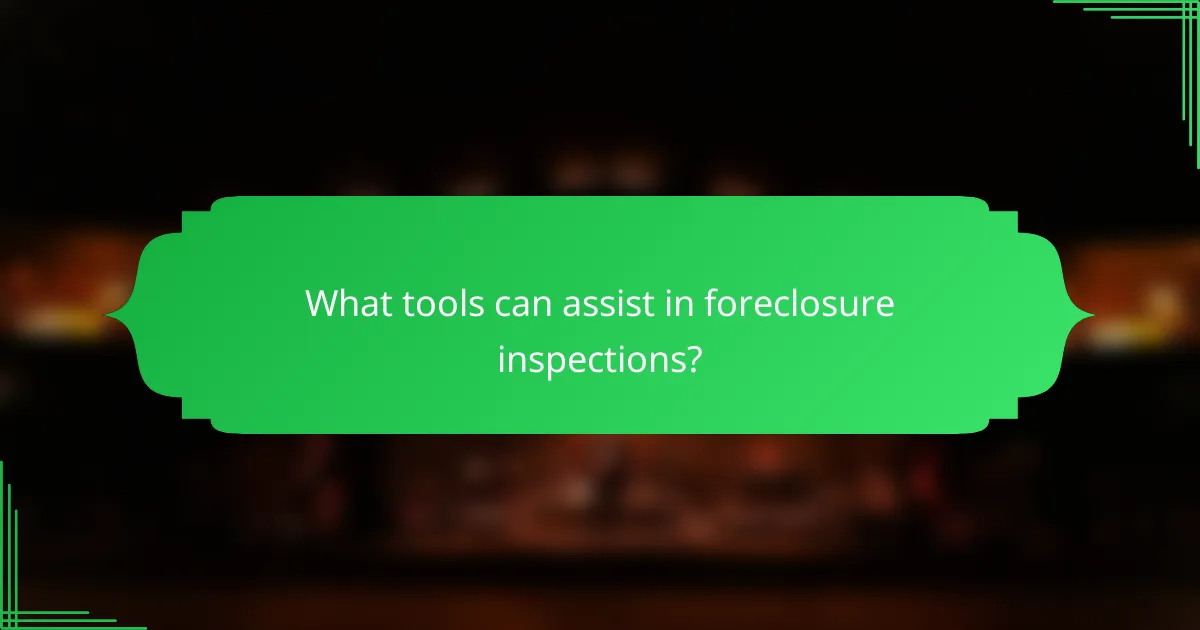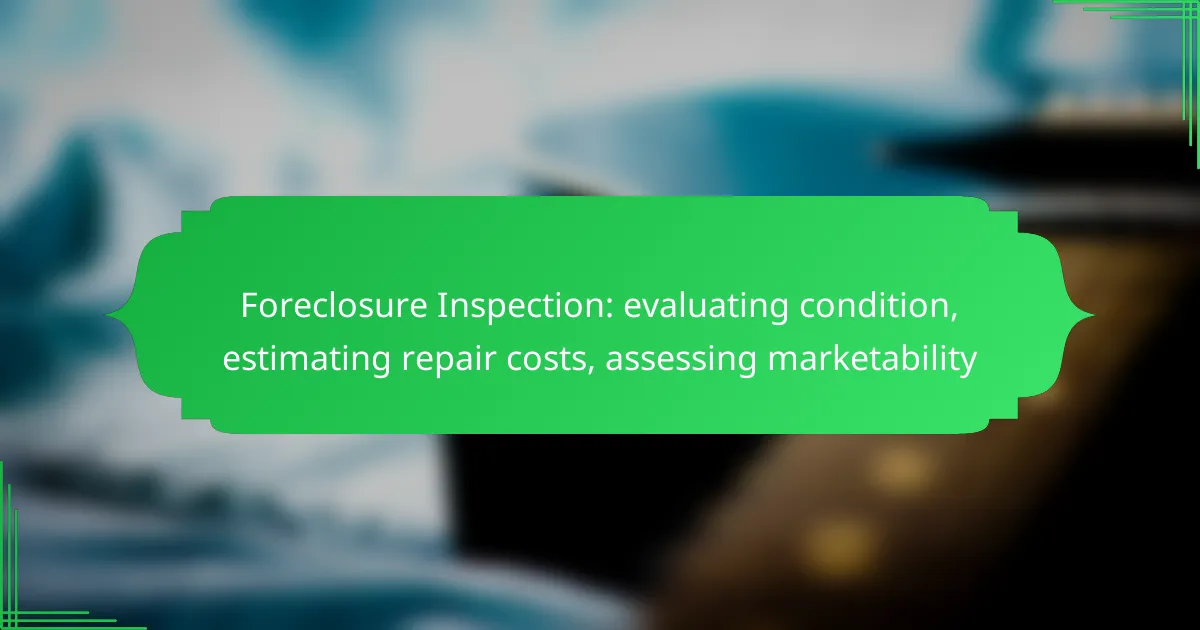Foreclosure inspections are essential for evaluating a property’s condition and estimating necessary repair costs, which directly impact its marketability. By identifying visible issues during the inspection, homeowners can better understand the investment potential and anticipate expenses that may arise from repairs. Additionally, assessing factors such as location and buyer interest is crucial for determining how quickly and profitably the property can be sold.

How to evaluate foreclosure property condition?
To evaluate the condition of a foreclosure property, conduct a thorough inspection to identify visible issues and estimate potential repair costs. This assessment is crucial for determining the property’s marketability and investment potential.
Visual inspection techniques
Start with a comprehensive visual inspection of both the interior and exterior. Look for signs of water damage, mold, or structural cracks, which can indicate deeper issues. Take detailed notes and photographs to document findings for future reference.
Utilize tools like moisture meters or infrared cameras to detect hidden problems. These devices can help identify leaks or insulation issues that may not be visible to the naked eye.
Common structural issues
Common structural issues in foreclosures include foundation cracks, roof damage, and framing problems. Foundation cracks can lead to significant repair costs, often ranging from hundreds to thousands of dollars, depending on severity.
Roof damage can manifest as missing shingles or leaks, which may require replacement or extensive repairs. Be aware that structural issues can severely impact the property’s value and marketability.
Utilizing home inspection services
Hiring a professional home inspector can provide a more thorough evaluation than a DIY inspection. Inspectors are trained to identify issues that may be overlooked and can offer a detailed report on the property’s condition.
While this service typically costs a few hundred dollars, it can save you from costly surprises later. Ensure the inspector is certified and has experience with foreclosures to get the most accurate assessment.
Importance of pest inspections
Pest inspections are essential for identifying infestations that can cause significant damage, such as termites or rodents. These pests can compromise the structural integrity of the property and lead to costly repairs.
Investing in a pest inspection can cost around $100 to $300, but it is a small price to pay compared to the potential damage that may go unnoticed. Addressing pest issues early can enhance the property’s appeal to future buyers.
Assessing exterior and interior damage
Assessing both exterior and interior damage involves checking for issues like peeling paint, broken windows, and damaged flooring. Exterior damage can affect curb appeal, while interior damage can impact livability and safety.
Make a checklist of areas to inspect, including siding, gutters, plumbing, and electrical systems. Prioritize repairs based on safety concerns and potential return on investment to maximize marketability.

What are the costs associated with repairs?
The costs associated with repairs in a foreclosure inspection can vary significantly based on the property’s condition and the extent of necessary work. Homeowners should anticipate expenses for both minor and major repairs, which can range from a few hundred to several thousand dollars.
Estimating repair costs for common issues
Common issues in foreclosures often include roof damage, plumbing leaks, electrical problems, and mold remediation. For instance, roof repairs can cost between $1,000 and $10,000 depending on the severity, while plumbing fixes typically range from $200 to $1,500. Understanding these ranges helps in budgeting effectively.
It’s advisable to conduct a thorough inspection to identify these issues early, as addressing them promptly can prevent further deterioration and higher costs down the line.
Factors influencing repair expenses
Several factors can influence repair expenses, including the age of the property, the quality of materials used, and local labor rates. Older homes may require more extensive repairs due to outdated systems, which can increase costs significantly.
Additionally, geographic location plays a crucial role; for example, labor rates in urban areas tend to be higher than in rural regions. Seasonal factors can also affect pricing, with some contractors charging more during peak seasons.
Using cost estimation tools
Cost estimation tools can provide valuable insights into potential repair expenses. Online calculators and software can help homeowners input specific details about their property to generate estimated costs for various repairs.
Utilizing these tools can streamline the budgeting process, allowing for more accurate financial planning. However, it’s essential to cross-reference these estimates with local contractor quotes for a more precise understanding.
Comparing contractor quotes
When comparing contractor quotes, it’s crucial to ensure that estimates are for the same scope of work. Request detailed breakdowns from each contractor to identify differences in pricing and services offered.
Look for contractors with good reviews and a solid track record in similar projects. It’s often beneficial to get at least three quotes to gauge the market rate and avoid overpaying for repairs.

How to assess marketability of a foreclosure?
To assess the marketability of a foreclosure, evaluate its condition, location, and potential buyer interest. Understanding these factors helps determine how quickly and profitably the property can be sold.
Analyzing local real estate trends
Start by researching recent sales in the area to identify trends in property values and buyer demand. Look for patterns such as rising or falling prices, average days on the market, and the ratio of listings to sales. This data will provide insight into whether the foreclosure is positioned well in the current market.
Utilize online real estate platforms and local market reports to gather this information. Pay attention to seasonal fluctuations that may affect market activity, as these can influence your pricing and marketing strategies.
Evaluating neighborhood conditions
The neighborhood’s overall condition significantly impacts a foreclosure’s marketability. Assess factors like crime rates, school quality, and proximity to amenities such as parks and shopping centers. A desirable neighborhood can enhance the property’s appeal, while a declining area may deter potential buyers.
Consider visiting the neighborhood at different times of day to gauge activity levels and overall atmosphere. Engaging with local residents can also provide valuable insights into community dynamics and future developments that might affect property values.
Determining potential buyer demographics
Identifying the target buyer demographic is crucial for effective marketing. Consider factors such as age, income levels, and family size, which can influence buyer preferences. For example, a foreclosure in a family-friendly neighborhood may attract buyers with children, while a property near nightlife may appeal to young professionals.
Conduct surveys or analyze demographic data from local government sources to understand who is likely to be interested in the property. Tailoring your marketing approach to these demographics can enhance the chances of a successful sale.
Setting competitive pricing strategies
Pricing a foreclosure competitively is essential for attracting buyers. Start by comparing similar properties in the area to establish a baseline price. Consider factors such as the property’s condition, necessary repairs, and current market trends to adjust your pricing strategy accordingly.
Avoid overpricing, as this can lead to prolonged market time and potential price reductions later. Instead, consider pricing slightly below market value to generate interest and encourage multiple offers, which can drive up the final sale price.

What criteria should be considered for a foreclosure inspection?
When conducting a foreclosure inspection, it’s essential to evaluate the property’s overall condition, estimate necessary repair costs, and assess its marketability. These criteria help determine the potential investment value and guide future decisions regarding repairs and resale.
Inspection checklist essentials
An effective inspection checklist for a foreclosure should cover key areas such as the roof, plumbing, electrical systems, and structural integrity. Inspectors should look for signs of water damage, mold, or pest infestations, as these can significantly affect repair costs and marketability.
It’s advisable to document findings with photographs and detailed notes to provide a clear picture of the property’s condition. This documentation can be invaluable when estimating repair costs and negotiating with potential buyers or contractors.
Legal considerations in foreclosure inspections
Foreclosure inspections must comply with local laws and regulations, which can vary by jurisdiction. It’s crucial to understand the rights of the current occupants and any legal restrictions on accessing the property. In some cases, obtaining permission from the lender or a court may be necessary.
Additionally, inspectors should be aware of any outstanding liens or claims against the property, as these can impact its marketability and the buyer’s ability to secure financing. Consulting with a real estate attorney can help navigate these legal complexities effectively.

What tools can assist in foreclosure inspections?
Various tools can enhance the efficiency and accuracy of foreclosure inspections. These tools include specialized software and mobile applications designed to evaluate property conditions, estimate repair costs, and assess marketability.
Home inspection software options
Home inspection software streamlines the process of documenting property conditions and generating reports. Popular options include HomeGauge, Spectora, and 3D Inspection System, which offer features like customizable templates, photo integration, and cloud storage for easy access.
When selecting software, consider factors such as user-friendliness, compatibility with mobile devices, and customer support. Pricing typically ranges from monthly subscriptions around $30 to one-time purchases costing several hundred dollars, depending on the features included.
Mobile apps for property assessments
Mobile apps provide a convenient way to conduct property assessments on-site. Apps like Zillow, PropertyRadar, and Evernote can help inspectors gather data, take notes, and capture images directly from their smartphones or tablets.
When using mobile apps, ensure they offer offline capabilities, as internet access may be limited during inspections. Additionally, look for features that allow for easy sharing of reports with clients or stakeholders, which can enhance communication and decision-making.

What are the emerging trends in foreclosure inspections?
Emerging trends in foreclosure inspections focus on the integration of technology, enhanced data analysis, and a shift towards sustainability. These trends aim to improve the efficiency and accuracy of inspections while addressing the growing demand for environmentally friendly practices.
Evaluating Condition
Evaluating the condition of a foreclosed property involves a thorough assessment of its structural integrity and overall state. Inspectors typically check for issues such as water damage, mold, and the condition of major systems like plumbing and electrical. A detailed inspection report can help buyers understand potential risks and necessary repairs.
Using technology such as drones and thermal imaging can enhance the evaluation process. These tools allow inspectors to identify hidden problems that may not be visible during a standard walkthrough, providing a more comprehensive view of the property’s condition.
Estimating Repair Costs
Estimating repair costs for a foreclosed property requires a careful analysis of the identified issues and local market rates for repairs. Costs can vary significantly based on location, with urban areas often seeing higher labor and material expenses compared to rural regions. It’s advisable to gather multiple quotes from local contractors to get an accurate estimate.
Common repairs may include roof replacement, plumbing updates, and electrical work. A rough estimate for minor repairs might range from a few thousand to tens of thousands of dollars, while extensive renovations could exceed that significantly.
Assessing Marketability
Assessing the marketability of a foreclosed property involves evaluating its appeal to potential buyers based on location, condition, and current market trends. Properties in desirable neighborhoods or with unique features may attract more interest, even if they require repairs.
To enhance marketability, consider staging the property or making minor cosmetic updates. Researching comparable sales in the area can provide insights into pricing strategies and help determine a competitive listing price. Understanding local buyer preferences is crucial for maximizing the property’s appeal.
